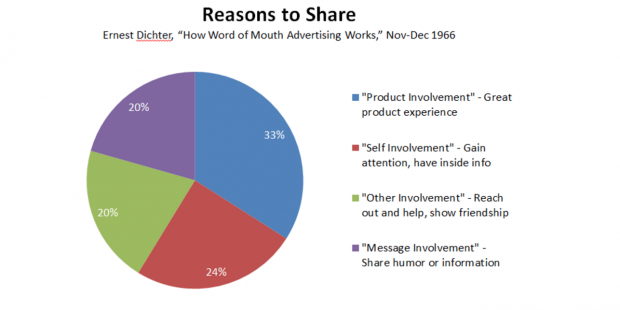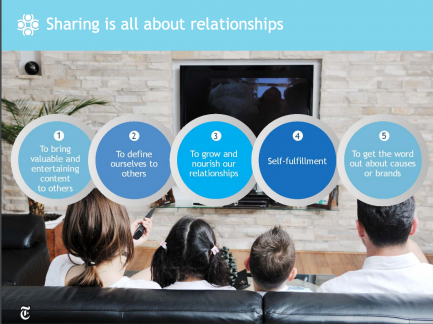When click bait is DEAD (as everyone is saying) I’ll be the first person to scream with joy.
Luckily, click bait may finally be on its way out as I’ve noticed across multiple industries that it’s simply not working as well as it was during peak BuzzFeed, Upworthy and other viral mills.
The best approach isn't creating content that is click-bait, it’s creating content that is click friendly. Meaning, the headline is still captivating but when you click the link, you’re met with blog posts of value, substance and quality information.
The most highly shared blog posts are not shared solely because they have a great headline. The most popular blog posts are shared because they deliver value once a reader takes the time to dive into the infographic, slides or words.
But beyond click friendly, you want to ensure that your content is share friendly. A share friendly piece of content is one that inspires people to email it to their colleagues, post in on their wall or tweet it to their followers.
And today, I’m going to share with you some of the insights, backed by research that go into share-friendly content.
Content Sharing Is An Age Old Behavior
It wasn’t more than 15 years ago when I was clipping pages out of newspapers or magazines and sharing them with parents, cousins or friends. The act of sharing information with other people is something that we’ve done for years as humans. From hieroglyphics to newspaper clippings – we’ve been storytellers since the beginning of time. Yet we’re still actively trying to understand motivations behind sharing as if we’ve changed so much.
Fifty years ago, psychologist and original Mad Man, Ernest Dichter released a large study of word of mouth and why people share. This study was conducted while many marketing gurus were still in diapers or were not even born. The most important finding in Dichter’s work was the identification of four motivations for a person to talk about a brand.
The Reasons We Share Content Hasn’t Changed Much
In this study he described four antecedents of word-of-mouth communication: product involvement, self-involvement, other involvement, and message involvement. This graph demonstrates the initial findings:
Fast-forward to 2004 and this research was built upon further by other researchers. The new research included Dichters work from 1966 but included added social benefits and economic incentives to the equation.
Resulting in the following framework for why we share:
- Product involvement: Defined as an individual’s connection to message content. The content needs to resonate with an individual personal worldview.
- Self involvement is defined as an individual’s desire for personal gain. The content may be something they developed or are mentioned in.
- Other involvement is defined as an individual’s concern for the welfare of others. The content raises awareness about a cause or topic that they want people to care about.
- Message involvement is defined as an individual’s interest resulting from well devised marketing and messaging strategies. The content is so entertaining that the reader wants to pass it on.
- Social benefit is defined as an individual’s enjoyment derived from social connection. The content is something that the reader feels a friend, peer or colleague would benefit from.
- Monetary involvement is defined as the person gaining monetary gain from sharing the content. The content has the ability to make the sharer money
While the world we live in today is very different than it was 50 years ago, motivations stay the same.
The difference today is in how content is shared, how frequently it’s shared and how much content is created every single day. To suggest that it’s overwhelming would be an understatement. That’s the benefit of using tools like Crate and Pocket to filter through the noise and find what’s relevant to your interests.
What Do The Most Recent Studies Tell Us?
One of the most frequently shared studies on the topic surrounding why people share content online over the last few years has been a report done by The New York times on the psychology of sharing. In this study, they asked three key questions:
1) What motivates consumers to share content?
2) Are there distinct personalities with different motivations?
3) How can understanding why people share help advertisers?
The study was groundbreaking because for one of the first times, researchers were able to determine which areas of the brain were triggered during the sharing process. The study concluded that the primary reasons for sharing were linked to relationships:
As you can see, the findings here are very similar to those found in the updated Dichter study. What’s great about the NYT study on why we share is that it communicates the motivations in a way that are easy to understand. It clearly identifies that the underlying reason we share content is to influence or relationships.
What Types Of Blog Posts Get The Most Shares
Fractl recently partnered with BuzzStream to analyze 220,000 articles from 11 verticals. In this study, they sought out to uncover insights around what types of blog posts were shared most frequently. In this study, they looked at a few different types of posts: how-tos, lists, why-posts, what-posts and video content. Here’s how they defined them:
- How-to posts highlight a problem, deliver a solution, and then share steps that will help achieve desired result.
- Lists are what you expect – a specific topic with a number of points and a conclusion.
- What-posts offer information and insights on a specific topic, with many articles surrounding comparisons of one thing to another.
- Why-posts offer readers with a reason or purpose and provide details that support a specific conclusion.
In their study, they found that list posts and why-posts were the most consistent for generating month over month shares while what-posts were the most volatile.
So I sought out to dig up some of the most popular blog posts over the last year from sites like BuzzFeed, Medium, Inc, Time, Huffington Post and more. My goal was to identify trends within the content that was similar across all of their most popular posts.
Here’s what I found:
1) Link Your Content To A Common Truth/Worldview
The most popular articles connected with a worldview or interest that is specific yet popular. What is a worldview? A worldview is your descriptive model of how you view the world today. It’s what how you explain your intentions, what’s true about your life, what’s false, what you want to do in the next 5 years and how you’ll do that. It’s a perspective that has been developed over time through interactions with parents, friends, information, genetics, experiences and it dictates how you view the world around you.
As noted in one of the Core Tenets of The Worldview Exploration Project created by the Institute for Noetic Sciences,
“The constellation of personal values, beliefs, assumptions, attitudes, and ideas that make up our worldview have an affect on our goals and desires, relationships and behaviors. The more aware we become of our worldview and the worldviews of others, the more effectively we can navigate through life.”
Articles like “21 things you know only if you’ve been best friends for 10 years” tap into a broad truth amongst anyone with an old friend. People sharing this link will likely pass it along to their friends with the intent of growing and nourishing existing relationships. Another example is from Time; “How To Parent Like A German.” This article allows German parents to define themselves to others and establish self-fulfillment while connecting with their worldview.
2) Break News or Hot Content
Some of the most popular content shared wasn’t how-to articles or why-posts; they were simply short paragraphs with embedded videos or photo carousels at the bottom. It’s a tactic that allowed sites like UpWorth and BuzzFeed to rise in popularity just a few years ago. It’s the idea of finding a piece of content before it truly goes viral, embedding it on your website, writing a great headline and sharing it on social
For example, in this post This Insane Amethyst-Inspired Wedding Cake Will Blow Your Mind, BuzzFeed simply takes photos from a cake company's Facebook page and embeds the Facebook video (1.3M+ views) at the bottom like this:
Here's what you don't get to see from pictures… Depth! This geode cake is made from edible sugar crystals!Created for…
Posted by Intricate Icings Cake Design on Friday, January 22, 2016
This article was one of their most viral pieces of the month!
3) Invest In Compelling, Shareable & Entertaining Visuals
Across the board, all of the most shared posts on the various sites had visuals that were compelling, shareable or entertaining.
The compelling visuals were the ones that once shared on Facebook would assist in luring a user to click the link. The shareable ones were those that could be tweeted individually and offer value to those who see it. And entertaining visuals were funny pictures that would simply put a smile on your face if you saw it.
Earlier on, I talked about the importance of making your content share-friendly. One way to ensure your content is share friendly is to include images that are compelling, shareable or entertaining. To demonstrate the power of visuals in your content, Buffer conducted a study that found that tweets shared with images were more likely to be shared. So before you push publish, include visuals to support your content and further tell your story.
4) Animals + Feelings = Success
One of the most popular articles on Inc.com in January was a behind the scenes look at the inside of the World’s Most Dog Friendly Office. In the article, the author gave a photo tour (reiterating my last point about the power of images) of the various perks dogs received in this company’s office.
To my surprise, this wasn’t the only time animal focused articles were found to be some of the most viral articles. Two of the top stories on Mashable were about a man knitting sweaters for penguins and a woman knitting jumpers for chickens. This trend continued across multiple sites confirming that people love reading and sharing content about people helping animals.
5) Lists Are Still A Great Content Technique
The top five most popular articles from BuzzFeed were all list posts. It wasn’t a huge surprise but with so many people suggesting that list posts are dead or lazy, it was interesting to see that they still work. Fom Business Insider, Mashable and even Time; lists were found consistently in the top five articles.
In 2013, The New Yorker published “” describing the reason why we love this approach:
Once we click, lists tap into our preferred way of receiving and organizing information at a subconscious level; from an information-processing standpoint, they often hit our attentional sweet spot. When we process information, we do so spatially. For instance, it’s hard to memorize through brute force the groceries we need to buy. It’s easier to remember everything if we write it down in bulleted, or numbered, points.
The other reason people like lists is that they enjoy skimming!
In a world where our attention is being pulled in a handful of different directions and distractions are everywhere – lists offer the ability to skim through a post with ease, get the key points and move on.
So What’s Next?
Now that you have a good understanding of what goes into viral content and what inspires people to tweet or share – it’s time to create content worth sharing.
My content has been seen and shared thousands of times online and it’s because I embrace these insights. It’s because I understand the importance of embracing the research and leveraging psychological insights when crafting a message.
It’s now your turn.
Take these insights and create something worth sharing!
What’s the number one thing you took from this article? I’d love to hear from you in the comments.
About Author
Kim Garst
Kim Garst is a renowned marketing strategist and speaker who is trailblazing the use of artificial intelligence in digital marketing. With over 30 years of experience as an online entrepreneur, Kim helps entrepreneurs grow their business and authority online by using AI technology. She is leading the way with proven AI frameworks that help entrepreneurs build authority in their space.
She is keynote speaker and an international best-selling author of Will The Real You Please Stand Up, Show Up, Be Authentic and Prosper in Social Media.
Named by Forbes as a Top 10 Social Media Power Influencer, Kim is well-known for her skill to simplify complex technology and make the use of AI understandable for business growth. Her relatable, actionable advice helps guide new entrepreneurs to harness the power of AI to succeed in digital marketing. Kim is leading the way in combining human and technological skills to create a new model for AI-powered marketing.










Great post. So rich with relevant content. This post is what I would call a how-to post. I was surprised that they’re not more viral but your research shows otherwise. Our agency produces a lot of them to share our expertise but know I will encourage my team to make them how-to lists, include viral visuals or be sure to speak to our target market’s world view. Thank you for sharing these insights.
Excellent Article, Ross! Great insights that I plan to adopt.
I have learned huge knowledge from here. I am waiting for your updates
Thank you so much for this very informative blog. Been searching for something like this. Keep it coming.